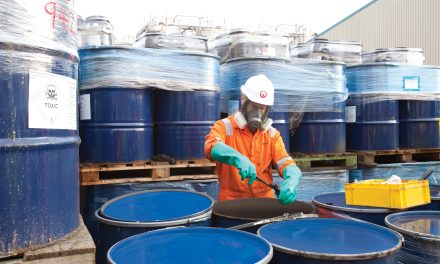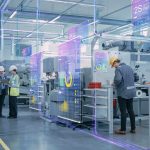Here, Chris Potts, Marketing Director at ANT Telecom, discusses whether ‘Covid-safe’ is guidance enough for life after lockdown and whether businesses could be doing more to limit the spread of Covid-19.
It is clear that the Coronavirus pandemic will continue into 2021, with restrictions and guidelines still in place for Covid-secure work environments. But, in order for employees to resume work back at the physical office without worrying about spreading the virus, companies need to consider introducing additional protocols to ensure that the workplace is, in fact, safe.
The HSE has outlined guidelines for ‘Covid-safe’ workplaces, including simple solutions such as social distancing and hand washing, but do they go far enough to sufficiently protect employees? Technology can support businesses to go beyond the basic requirements in order to further prevent the spread of the virus and business closures associated with it.
We all hope with the roll out of the vaccine program, things will get back to normal (whatever normal will be) sometime in the Autumn – with far fewer (if any) restrictions in place at all. By then, it is forecasted that the whole of the UK adult population will have some immunity against the virus so you would expect normal things to resume.
However, it would be prudent for businesses and employees not to drop their guard completely, as there is always the ongoing threat of mutated strains of the virus – ones that the current vaccines provide less protection against. Of course, vaccines will be updated to combat new strains but there will be a period between discovery and immunity, where the virus can spread more easily and we can all be at greater risk.
No one wants to go back to full lockdowns or even a tiered system where so many businesses are shut and office staff are forced to work from home. Which means implementing new procedures and perhaps new technology to help reduce the rate of transmission in order to keep it contained.
Temperature Monitoring
Temperature monitoring provides one solution that could aid businesses looking to implement safer practices which go beyond Covid-safe government recommendations. This solution works by enabling companies to have a clearer picture of whether or not an employee or customer has a raised temperature, helping them to avoid potentially unwell people entering the establishment and spreading the disease.
Temperature checks and monitoring offer early detection of Covid-19 which is essential to preventing the spread of the virus. Thermal imaging can be used to regularly measure temperature, while also being discreet where needed. Those with high temperatures can then take the proactive steps to use the government’s testing system and self-isolate if deemed necessary to avoid any potential escalation.
For locations where multiple temperatures need to be checked at one time, cameras can be calibrated in order to achieve this. Screening terminals are plug and play and can be quickly and easily installed, even without the need for third-party installation on site – providing instant reassurance for those attending the facility and limiting further outside contact. Systems can also offer facemask detection and can even be expanded to allow remote camera viewing for those entrances that cannot be manned all the time, resulting in a more Covid-secure workplace.
Test and Trace
With many organisations remaining open throughout lockdown, social distancing measures are an important barrier against spreading infection, companies need to ensure that they have the mechanisms in place to protect their workers. It is essential for companies to have more visibility in order to remain open and secure in the knowledge they are doing everything they can to safeguard their staff and business. Warehouses and factories for example cannot afford to shut down the whole system because one or two members have tested positive for the virus.
Unfortunately, the NHS test and trace app, has reportedly had a ‘marginal impact’ and has not been very successful in identifying and preventing the spread, but a more specific and nuanced approach could play an incredibly helpful role in keeping these businesses open. A private test and trace system installed by a business offers a way of narrowing the outbreak identified in the workplace and containing it. By wearing tags that connect with each other and automatically identify when they come near, contact tracing records the history of these contacts in a database. The tags relay their contacts to cloud software platforms over existing wireless networks, meaning if someone has Coronavirus, they can easily identify who they have been near. Additionally they help maintain six feet of separation through alerting the wearer if they get too close to another tag.
This type of solution allows companies to control an outbreak rather than the situation spiraling out of control because they cannot identify who could have the virus, thus having little choice but to temporarily close the entire organisation down resulting in potentially huge revenue loss.
Practicing social distancing safely
For staff that are currently working in factories and warehouses, it may be at a limited capacity in order to promote Covid-safe workplaces. This means that there will be an increased likelihood of lone workers and companies need to consider ways to protect these workers as they may have no longer have colleagues around them to raise alarms, should something happen. Secondly, due to social distancing measure, workers are less likely to converse face-to-face, so companies need to look at alternative ways to help teams collaborate.
Ideally, businesses need a way to tackle both factors together to aid safe working conditions. Companies are able to add this into one multifunctional device which enables workers to communicate with their team and raise alarms in the event of an emergency if they are working alone.
Combining these functions into one streamlined device further means that workers don’t need to worry about having different devices on them throughout the working day. Panic buttons, tilt and no-motion sensors, push to talk (PTT) technology and other comprehensive communication and lone worker protection functions can be integrated into one tailored device. Based on Digital Radio or smartphone technology, devices can be compact and robust, capable of reliably transmitting communications and alerts over private radio or 2G, 3G, 4G and Wi-Fi networks.
These communications methods available on the one device can safeguard staff working alone due to social distancing requirements and can be fine-tuned to suit a business’ requirements. This is essential to ensure that the solution focuses on the individual requirements of a company, especially during a time when everyone is adapting to the new-norm.
Conclusion
These solutions are not only beneficial to businesses for going above and beyond government recommendations to promote a more Covid-safe workplace, but to protect employees. Workers will feel more secure with regular temperature checks using thermal imaging devices and by adopting a private test and trace system employees will have confidence knowing that the spread of the virus is being carefully monitored at their workplace. Furthermore lone worker solutions will promote safer practices for those who can no longer work closely with colleagues due to social distancing. It’s clear that technology can provide an effective barrier against the spread of the virus, and support businesses from a commercial angle too.






